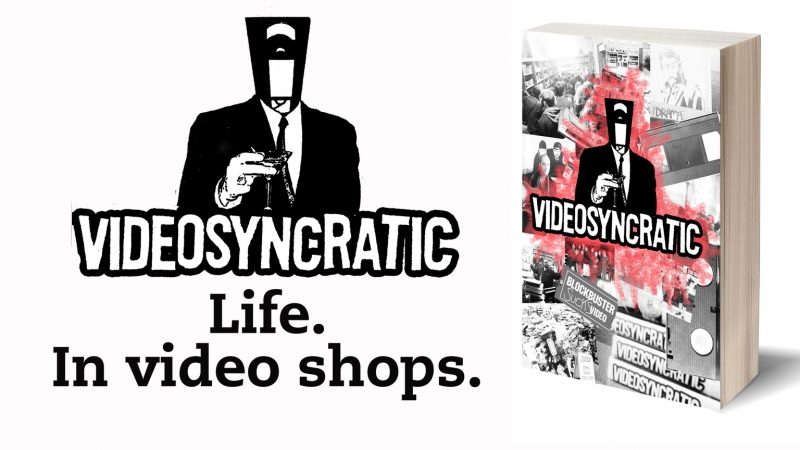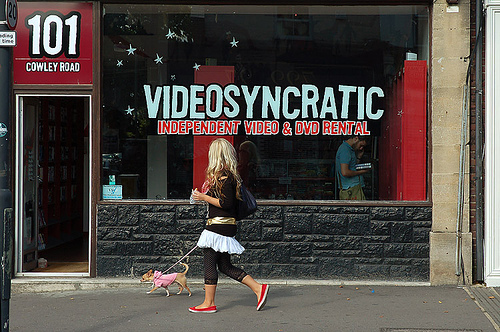Books: Videosyncratic
April 5, 2017 · 0 comments
By Jonathan Clements.
 “When you love film,” writes Jon Spira in his Kickstarted book Videosyncratic, “it doesn’t just transport you to another world. It transports you back to where you were, who you were, when you first saw it. Hours sat with friends now missing or lost. Sunday afternoons on the sofa with your family. Youthful fumblings with girls in cinemas. Heated debates with friends in pubs which no longer exist. You remember the awe of your first Kubrick film. The delight of your first Ghibli experience. The uncontrollable giggles of your first Monty Python flick.”
“When you love film,” writes Jon Spira in his Kickstarted book Videosyncratic, “it doesn’t just transport you to another world. It transports you back to where you were, who you were, when you first saw it. Hours sat with friends now missing or lost. Sunday afternoons on the sofa with your family. Youthful fumblings with girls in cinemas. Heated debates with friends in pubs which no longer exist. You remember the awe of your first Kubrick film. The delight of your first Ghibli experience. The uncontrollable giggles of your first Monty Python flick.”
I am already encountering students and researchers with no memories of the media of the 20th century, who never had to fast-forward through a Simon Bates warning; who can pause and rewatch with pinpoint accuracy; who do not appreciate the concept of waiting, of not bingeing. They need to read this book.Spira helps ground his readers in a historical context by rewinding way, way back, to the kind of customer journey his great-grandfather would have had to go on to see a screening of Fritz Lang’s Metropolis in 1927. He’d have had to dress nicely, and get the bus into Central London, and sit through the preliminary programme with its Wurlitzer serenade and newsreels, and concentrate really hard because he was unlikely to see it again. And today? As Spira notes, you don’t even have to get out of bed to be able to access a bunch of variant Metropolis movies on your phone. Some of which, you don’t even have to pay for.
But Spira is interested in his own culture of entertainment. More specifically, the generation spanning 1983 to the early 2000s, the first generation that was effectively given control over exhibition. For people of Spira’s era, the VHS cassette could turn your home into a cinema and your lounge into an archive. It was, as Yasuo Nagayama observed in his history of Japanese fandom, a huge disruption to the nature of film-watching all over the world, equivalent, in his words, to “the discovery of time travel.”
Like Matthew Sweet on a sugar rush, Spira delves into the lost architecture of the 1980s high street, dragging the reader around kebab shops and carpet warehouses that used to be video stores. He is passionate about summarising the customer journey of the late 20th century, but he is refreshingly interested in the impact of the video cassette recorder, not merely the video cassette itself. He recalls the joyful discovery of time-shifting, being able to watch a programme whenever he wants, and the miseries of trawling through two separate listings magazines to find when something’s on. His tale is soon awash with vivid memories of dodgy scanlines and drop-outs; of the ad breaks that peppered films recorded from the telly, and of the perils of taping over someone else’s prized cassette.
But it’s video rental that really changes the world of the would-be 1980s cineaste, and Spira does not disappoint in his account of the sudden liberalisation of access to film. He fondly remembers the days before the BBFC started rating home video, when his parents blanched at the sound of the F-word in Fame. He thrills in the chase of the Video Nasty campaign, and even the haptic raptures of the shape and feel of a Warner Bros video box. Before the reader can grow tired of his powerful evocation of the 1980s, he moves into a new sector, trying to make films of his own and, inevitably, getting a job at Blockbuster in its 1990s heyday.
 The tape costs Blockbuster £20. They rent it out 21 times in the first month it’s out, and then they flog it off for £15 ex-rental before it breaks. £70 profit. But what if you’re not Blockbuster? What if you’re an independent retailer without the heft of bulk-buying, who has to pay £60 a tape. You need to manage your resources much better. You need to invest in films that will keep monetising on the long tail… you need to curate your collection. By the end of the century, looking for a challenge, Spira is ready to be that guy. As video itself starts to die in the face of DVD, but before the cataclysm of digital, he starts running his own store. For a paragraph or so, he goes off to Canada to work as a writer on the sci-fi show Lexx…. But this interests him far less than the world of video stores, so before long we are back to the politics of late fees and the Customers from Hell. By the end, however, Spira is parleying his profits from the Videosyncratic store into the budget for a straight-to-video movie called Jerkbeast, and we get to see what the world of video looks like, not only from the production end, but in terms of marketing.
The tape costs Blockbuster £20. They rent it out 21 times in the first month it’s out, and then they flog it off for £15 ex-rental before it breaks. £70 profit. But what if you’re not Blockbuster? What if you’re an independent retailer without the heft of bulk-buying, who has to pay £60 a tape. You need to manage your resources much better. You need to invest in films that will keep monetising on the long tail… you need to curate your collection. By the end of the century, looking for a challenge, Spira is ready to be that guy. As video itself starts to die in the face of DVD, but before the cataclysm of digital, he starts running his own store. For a paragraph or so, he goes off to Canada to work as a writer on the sci-fi show Lexx…. But this interests him far less than the world of video stores, so before long we are back to the politics of late fees and the Customers from Hell. By the end, however, Spira is parleying his profits from the Videosyncratic store into the budget for a straight-to-video movie called Jerkbeast, and we get to see what the world of video looks like, not only from the production end, but in terms of marketing.
And of course, it all ends in tears. Spira offers a provocative account of the day that rental died, suggesting it was when Sainsbury’s offered day-date retail DVDs of the Daniel Craig Casino Royale for just seven quid. Why rent when you could just buy it?
Spira is out of the video game, but ends his wonderful little book with a warning for the future. “Films which have been shot and edited digitally and have existed only on hard drives are at almost as much risk as films from 100 years earlier which exist only on nitrate prints. I do worry about swathes of films disappearing once more, but my days of collecting, curating and putting them in peoples’ hands are over.”
Jonathan Clements is the author of Anime: A History.
Leave a Reply